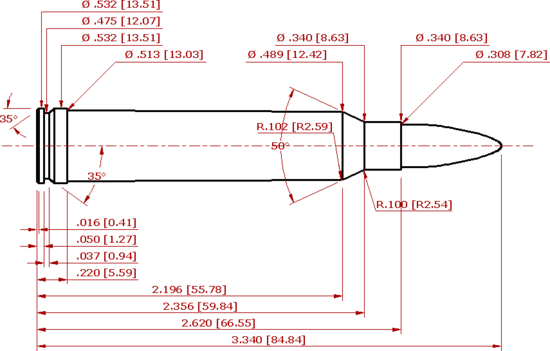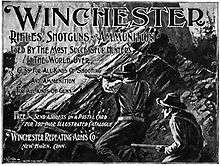.300 Winchester Magnum
The .300 Winchester Magnum (also known as .300 Win Mag or 300WM) (7.62×67mmB) is a belted, bottlenecked magnum rifle cartridge that was introduced by Winchester Repeating Arms Company in 1963. The .300 Winchester Magnum is a magnum cartridge designed to fit in a standard rifle action. It is based on the .375 H&H Magnum, which has been blown out, shortened, and necked down to accept a .30 caliber (7.62 mm) bullet.[3]
| .300 Winchester Magnum | ||||||||||||||||||||||||
|---|---|---|---|---|---|---|---|---|---|---|---|---|---|---|---|---|---|---|---|---|---|---|---|---|
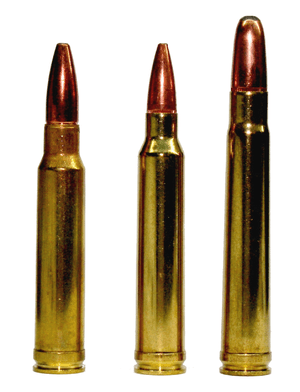 .300 Winchester Magnum (center) flanked by its parent cartridges: the .338 Winchester Magnum (left) and the .375 H&H Magnum (right). | ||||||||||||||||||||||||
| Type | Rifle, Large game | |||||||||||||||||||||||
| Place of origin | United States | |||||||||||||||||||||||
| Production history | ||||||||||||||||||||||||
| Designer | Winchester Repeating Arms Company | |||||||||||||||||||||||
| Designed | 1963 | |||||||||||||||||||||||
| Specifications | ||||||||||||||||||||||||
| Parent case | .375 H&H Magnum | |||||||||||||||||||||||
| Case type | Belted, bottleneck | |||||||||||||||||||||||
| Bullet diameter | .308 in (7.8 mm) | |||||||||||||||||||||||
| Neck diameter | .339 in (8.6 mm) | |||||||||||||||||||||||
| Shoulder diameter | .489 in (12.4 mm) | |||||||||||||||||||||||
| Base diameter | .513 in (13.0 mm) | |||||||||||||||||||||||
| Rim diameter | .532 in (13.5 mm) | |||||||||||||||||||||||
| Rim thickness | .049 in (1.2 mm) | |||||||||||||||||||||||
| Case length | 2.62 in (67 mm) | |||||||||||||||||||||||
| Overall length | 3.34 in (85 mm) | |||||||||||||||||||||||
| Case capacity | 93.8 gr H2O (6.08 cm3) | |||||||||||||||||||||||
| Rifling twist | 1:10 (254 mm) | |||||||||||||||||||||||
| Primer type | Large Rifle Magnum | |||||||||||||||||||||||
| Maximum pressure (C.I.P.) | 62,366 psi (430.00 MPa) | |||||||||||||||||||||||
| Maximum pressure (SAAMI) | 64,000 psi (440 MPa) | |||||||||||||||||||||||
| Maximum CUP | 54,000 CUP | |||||||||||||||||||||||
| Ballistic performance | ||||||||||||||||||||||||
| ||||||||||||||||||||||||
| Test barrel length: 24 inches (61 cm) Source(s): Accurate Powders load guide v3.5[1] Hodgdon powders achieve approx 100fps less.[2] | ||||||||||||||||||||||||
The .300 Winchester is extremely versatile and has been adopted by a wide range of users including hunters, target shooters, military units, and law enforcement departments. Hunters found the cartridge to be an effective all-around choice with bullet options ranging from the flatter shooting 165 grain to the harder hitting 200+ grain selections available from the factory. The .300 Win Mag remains the most popular .30 caliber magnum with American hunters, despite being surpassed in performance by the more powerful .300 and .30-378 Weatherby Magnums and the newer .300 Remington Ultra Magnum.[4] It is a popular selection for hunting moose, elk, and bighorn sheep as it can deliver better long range performance with better bullet weight than most other .30 caliber cartridges. Military and law enforcement departments adopted the cartridge for long range sniping and marksmanship. As a testament to its accuracy, since its introduction it has gone on to win several 1,000-yard (910 m) competitions.[5]
Cartridge history
Prior to the design of the .300 Winchester Magnum there were several cartridges that provided what could be best described as a magnum level of energy. The heritage of .30 caliber (7.62 mm) magnums can be traced back to the .30 Newton in 1913 and to the .300 H&H Magnum in 1925. The .300 H&H Magnum was too long for the Mauser and Springfield standard length rifle actions and required specialized rifles with a Magnum size action.
Beginning with the .270 Weatherby Magnum in 1943, Roy Weatherby introduced a line of cartridges that while based on the Magnum H&H case were shortened to fit a standard length (2.5 in [63.50 mm]) action. The Weatherby cartridges involved blowing out (reducing the taper) of the Magnum H&H cases, bottlenecking them to the required caliber and shortening them to fit the standard rifle actions of the era. The .300 Weatherby Magnum was introduced in 1944.
The Weatherby's standard length magnum case was soon noticed. In 1958 Winchester introduced three cartridges – the .264 Winchester Magnum, .338 Winchester Magnum and the .458 Winchester Magnum, all based on the shortened and blown out .375 H&H Magnum case. The popular .30 caliber's omission from that lineup was not missed. Wildcatters soon produced the .30-338 Winchester and Norma Projektilfabrik, who were by now manufacturing ammunition for Weatherby, took the standard length basic Weatherby brass and necked it down to .30 caliber (7.62 mm) and called it the .308 Norma Magnum.[6]
The .300 Winchester Magnum was introduced in 1963 by Winchester for use in the Model 70 rifle. The introduction of the .300 Winchester Magnum was not unforeseen; rather, its introduction was anticlimactic. Winchester developed the .300 Winchester Magnum by taking the .338 Winchester Magnum, which was introduced in 1958, and moved the shoulder forward by 4.0 millimetres (0.156 in) and lengthening it by 3.0 millimetres (0.120 in). This caused the cartridge to have a neck shorter than the diameter of the bullet. There has been some speculation that if the cartridge was released earlier, the dimensions of the cartridge would have matched the .30-338 Winchester wildcat cartridge. Since its introduction the cartridge has remained extremely popular.[7]
The .300 Winchester Magnum's high availability in popular rifles such as Winchester's Model 70 and Remington Model 700 made the cartridge a popular choice among the shooting public. Although the .300 H&H Magnum, .30-338 Winchester Magnum and the .308 Norma Magnum had a head start on the .300 Winchester Magnum these cartridges soon faded into obsolescence. Only the .300 Winchester Magnum was to survive as a readily available cartridge. Other cartridges, while available, are more expensive.
Design and specifications
The .300 Winchester uses the same case head design of the .375 H&H Magnum, its parent cartridge. The taper of the cartridge was reduced to provide the cartridge with more volume so as to increase its potential powder capacity. The lengthening of the case and the move of the shoulder forward over the .338 Winchester Magnum allowed for the reaming of the .308 Norma Magnum or .30-338 Winchester chamber to dimensions of the .300 Winchester Magnum. The down side was a neck which was shorter than the caliber of the bullet it fired, which meant that the bullet had to be seated more deeply in the case.
Cartridge dimensions
The ammunition standards organizations SAAMI (Sporting Arms and Ammunition Manufacturers' Institute) and C.I.P. (Commission Internationale Permanente pour l'Epreuve des Armes à Feu Portatives) have provided specifications for the .300 Winchester Magnum cartridge. Almost no divergence between C.I.P. and SAAMI dimensional values exist for this cartridge.
The case volume will vary from manufacturer to manufacturer to such a degree the reloading software suite QuickLOAD provides five differing cartridge case capacities, that for reloading purposes significantly differ between manufacturers.
The SAAMI specification .300 Winchester Magnum case capacity is 91.5 grains of H2O (5.93 ml).
For four ammunition manufacturers the cartridge case capacities are provided as:
Remington 88.0 grains of H2O (5.70 ml)
Federal 92.0 grains of H2O (5.96 ml)
Winchester 93.8 grains of H2O (6.08 ml)
Norma 95.5 grains of H2O (6.19 ml)
.300 Winchester Magnum SAAMI cartridge dimensions. All sizes in inches (in) and millimeters (mm). The projectile diameter should be 0.309 in (7.85 mm) [8]
SAAMI recommends a bore diameter of 7.6 millimetres (0.300 in) and a groove diameter of 7.8 millimetres (0.308 in). SAAMI recommended a six-groove barrel with each groove being 2.8 millimetres (0.110 in) wide. Recommended twist ratio is 1:10 (254 mm).
C.I.P. defines the common rifling twist rate for this cartridge as 254 mm (1 in 10 in), 6 grooves, Ø lands = 7.62 mm (0.300 in), Ø grooves = 7.82 mm (0.308 in), land width = 2.79 mm (0.110 in), and the primer type is large rifle magnum.
The SAAMI Maximum Average Pressure (MAP) for this cartridge is 441.3 MPa (64,000 psi) piezo pressure (54,000 CUP).[9]
According to the official C.I.P. (Commission Internationale Permanente pour l'Epreuve des Armes à Feu Portatives) rulings the .300 Winchester Magnum can handle up to 430.00 MPa (62,366 psi) Pmax piezo pressure. In C.I.P. regulated countries every rifle cartridge combo has to be proofed at 125% of this maximum C.I.P. pressure to certify for sale to consumers. This means that .300 Winchester Magnum chambered arms in C.I.P. regulated countries are currently (2013) proof tested at 537.50 MPa (77,958 psi) PE piezo pressure.[10]
Performance


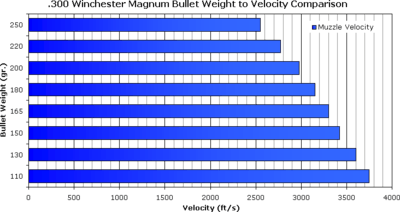
The Winchester's factory ammunition for the .300 Winchester Magnum is capable of 990 m/s (3,260 ft/s) with the 150-grain (9.7 g) bullet and 910 m/s (3,000 ft/s) with the 12-gram (180 gr) bullet, however old Western "Power Point" soft point can reach past 1,000 metres per second (3,400 ft/s) with 9.7 g (150 gr) projectiles. The maximum point blank range for the 9.7 g (150 gr) bullet is 291 metres (318 yd) yards when zeroed at 250 metres (270 yd). The maximum point blank range for the 12 g (180 gr) bullet is 300 yards when zeroed at 232 metres (254 yd). The ability to zero the .300 Winchester Magnum and shoot without hold over to 270 metres (300 yd) makes the cartridge one of the flatter shooting cartridges.
| Cartridge | Criteria | Muzzle | 100-yard (91 m) | 200-yard (180 m) | 300-yard (270 m) | 400-yard (370 m) | 500-yard (460 m) | |
| .308 Winchester (Winchester – SXP308) 150 gr (9.7 g) | Velocity | 2,825 ft/s (861 m/s) | 2,616 ft/s (797 m/s) | 2,417 ft/s (737 m/s) | 2,226 ft/s (678 m/s) | 2,044 ft/s (623 m/s) | 1,871 ft/s (570 m/s) | |
| Energy | 2,658 ft⋅lbf (3,604 J) | 2,279 ft⋅lbf (3,090 J) | 1,945 ft⋅lbf (2,637 J) | 1,650 ft⋅lbf (2,240 J) | 1,392 ft⋅lbf (1,887 J) | 1,166 ft⋅lbf (1,581 J) | ||
| .30-06 Springfield (Remington – PRA3006B) 165 gr (10.7 g) | Velocity | 2,800 ft/s (850 m/s) | 2,597 ft/s (792 m/s) | 2,403 ft/s (732 m/s) | 2,217 ft/s (676 m/s) | 2,039 ft/s (621 m/s) | 1,870 ft/s (570 m/s) | |
| Energy | 2,872 ft⋅lbf (3,894 J) | 2,470 ft⋅lbf (3,350 J) | 2,115 ft⋅lbf (2,868 J) | 1,800 ft⋅lbf (2,400 J) | 1,523 ft⋅lbf (2,065 J) | 1,281 ft⋅lbf (1,737 J) | ||
| .300 Winchester Magnum (Winchester – SXP300WM) 180 gr (12 g) | Velocity | 3,160 ft/s (960 m/s) | 2,983 ft/s (909 m/s) | 2,813 ft/s (857 m/s) | 2,649 ft/s (807 m/s) | 2,492 ft/s (760 m/s) | 2,339 ft/s (713 m/s) | |
| Energy | 3,992 ft⋅lbf (5,412 J) | 3,556 ft⋅lbf (4,821 J) | 3,163 ft⋅lbf (4,288 J) | 2,806 ft⋅lbf (3,804 J) | 2,482 ft⋅lbf (3,365 J) | 2,187 ft⋅lbf (2,965 J) | ||
| .300 Weatherby Magnum (Weatherby – N300180ACB) 180 gr (12 g) | Velocity | 3,250 ft/s (990 m/s) | 3,051 ft/s (930 m/s) | 2,861 ft/s (872 m/s) | 2,678 ft/s (816 m/s) | 2,503 ft/s (763 m/s) | 2,335 ft/s (712 m/s) | |
| Energy | 4,223 ft⋅lbf (5,726 J) | 3,721 ft⋅lbf (5,045 J) | 3,271 ft⋅lbf (4,435 J) | 2,868 ft⋅lbf (3,888 J) | 2,505 ft⋅lbf (3,396 J) | 2,179 ft⋅lbf (2,954 J) | ||
| Values courtesy of respective manufacturers | ||||||||
The most useful bullet weights for the .300 Winchester Magnum are those weighing between 150–200 grains (9.7–13.0 g). However, bullets weighing between 7.1–16.2 g (110–250 gr) are available to the reloader for the .300 Winchester Magnum.
Compared with the 30-06 Springfield the .300 Winchester Magnum provides a roughly 400 ft/s (120 m/s) increase in velocity. This translates to about 20% greater energy advantage over the 30-06 Springfield cartridge. Due to the short neck, heavier bullets particularly those weighing greater than 13 grams (200 gr) and mono-metal bullets such as the Barnes X bullets will need to be seated more deeply into the cartridge. As the bullet will take up volume which could have been taken by the propellant velocity advantages diminish as the weight of the bullet increases.
The .300 Winchester Magnum is known for its accuracy and has been used for 910-metre (1,000 yd) and 1,000-metre (1,100 yd) competitions. While in hunting situations such accuracy is unnecessary, such accuracy does aid in the extending the range of the cartridge. Taken together with its performance it remains one of the most useful and popular cartridges today.
Although cartridges such as the .30-378 Weatherby Magnum, .300 Remington Ultra Magnum and the .300 Weatherby Magnum all exceed performance of the .300 Winchester Magnum none of these cartridges can be chambered in a standard length action. Few .30 caliber (7.62 mm) standard length cartridges can match the performance and versatility of the .300 Winchester Magnum.
The down side to this performance is recoil. The amount of recoil the cartridge generates is a step up from the non-magnum .30 caliber (7.62 mm) cartridges. Its recoil is about 30% greater than that of the .30-06 Springfield,[11] which is known as a 'stout' cartridge. With the average load for the .300 Winchester Magnum, the recoil energy is roughly 30 ft lbs. This would put the .300 Winchester Magnum at the upper limit of what most shooters can shoot comfortably for extended shooting sessions. As a rough comparison, the recoil of the .300 Winchester Magnum is roughly comparable to a 12 gauge shotgun shooting 1 oz. slugs. This greater recoil can make the .300 Winchester Magnum, despite its inherent accuracy advantages, a harder cartridge to shoot accurately, when compared to non-magnum .30 caliber cartridges such as the .30-06 Springfield or the .308 Winchester. On the other hand, recoil is subjective (some are more sensitive to it than others) and one can get used to it with practice. Also, many rifles available today now have effective recoil attenuating features built into them, such as muzzle compensators and energy absorbing stocks and butt-pads, that can significantly lessen recoil as it is felt by the shooter.
Sporting applications and usage

The .300 Winchester Magnum is powerful enough to hunt any North American game animal.[12] It is particularly useful when hunting the members of the ungulate family such as elk and moose and is a popular cartridge among hunters for these class 3 game species. Elk can weigh as much as 450 kilograms (1,000 lb) and moose 640 kilograms (1,400 lb). Bullet weights of 10.7–13.0 grams (165–200 gr) are the preferred choices for these game species. Controlled expansion bullets such as the Nosler Partition or Barnes X are preferred rather than more lightly constructed bullets for these larger species of ungulate. Bullets weighing 9.7–10.7 g (150–165 gr) are adequate for smaller deer such as the mule deer and white-tailed deer.
With its velocity, low bullet drop and high energy retention, the .300 Winchester Magnum is useful for hunting sheep even at extended range.[13]
The .300 Winchester Magnum cartridge is very effective on dangerous class 3 game such as bear. Both black bears[14] and grizzly bears[15] are hunted using the cartridge. Many consider the .300 Winchester Magnum to be on the lighter side of what is required for the largest bears, but hunters have had success with the cartridge against these large bruins.[16]

The .300 Winchester Magnum is well-suited for 95% of the world's game. Due to its ability to shoot flat and carry its energy efficiently, the cartridge is one of the more favored rounds for African plains game. With bullets of good sectional density and ballistic coefficients the cartridge possesses the long range performance necessary to take large game species at extended ranges. The .300 Winchester Magnum can be used to hunt everything from the dik-dik to the giant eland. It is an excellent cartridge choice for all plains game under 680 kilograms (1,500 lb).
The .300 Win Mag sees use in long-range benchrest shooting competitions and has been adopted by law enforcement marksmen and by a few specific branches of the U.S. Military for use by snipers. Maximum effective range is generally accepted to be 1,210 yards (1,110 m) with ammunition incorporating low-drag projectiles. Sub 1 minute-of-angle (MOA) accuracy out to 1,000 yards (910 m) is not unusual in precision-built rifles firing match-grade ammunition.
Recoil from the .300 Win Mag is noticeably higher than the well-known and popular .30-06 Springfield. Subsequently, Remington has made low-recoil rounds called "Managed-Recoil" available for the .300 Win Mag, which recoil less while providing performance similar to the .30-06 Springfield.
Military and law enforcement applications
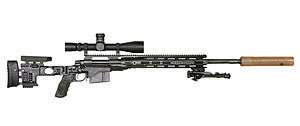
The U.S. government purchased MK 248 MOD 1 .300 Winchester Magnum match-grade ammunition in 2009 for use in adapted M24 Sniper Weapon Systems and other .300 Winchester Magnum sniper rifles like the U.S. Navy Mk.13s. This ammunition was developed as a .300 Winchester Magnum Match Product Improvement (PIP) and uses the 220 gr (14.26 g) Sierra MatchKing Hollow Point Boat Tail (HPBT) very-low-drag bullet fired at a nominal muzzle velocity of 2,850 ft/s plus or minus 50 ft/s (869 m/s ± 15.2 m/s). According to the U.S. Navy this ammunition should increase the maximum effective range of .300 Winchester Magnum sniper rifle systems to 1,500 yards (1,370 m), decrease wind deflection on bullets in flight and use Hodgdon H1000, a reduced muzzle flash propellant that remains temperature stable across an operational temperature range of −25 °F to +165 °F (−32 °C to 74 °C).[17][18][19] The 3.55 in (90.2 mm) long MK 248 MOD 1 or alike ammunition is not offered commercially, since it exceeds SAAMI standards for overall length and maximum chamber pressure. However, the handloader can take advantage of modern advances in powder technology and actually exceed the velocity of the MK 248 MOD 1 cartridge while still loading to maximum SAAMI cartridge overall length, and maintaining safe pressure. [20]
According to JBM Ballistics,[21] using the G7 ballistic coefficient provided by Bryan Litz, and a Weapon Employment Zone (WEZ) analysis of the XM2010 rifle with various .300 Winchester Magnum ammunition types by Bryan Litz, the MK 248 MOD 1 .300 Winchester Magnum cartridge, when fired at its nominal muzzle velocity of 869 m/s (2,850 ft/s), should have 1,286 to 1,289 m (1,406 to 1,410 yd) supersonic range under International Standard Atmosphere conditions at sea level (air density ρ = 1.225 kg/m3).[22]
In January 2014, the U.S. Department of Defense annual testing report found that the older A191 or MK 248 Mod 0 .300 Winchester Magnum service round loaded with aerodynamically less efficient 190 gr (12.32 g) Sierra MatchKing Hollow Point Boat Tail (HPBT) bullets fired from the XM2010 demonstrated adequate performance and lethality. Live fire tests were conducted in March 2013 against ballistics gelatin, light material barriers, and other targets to determine the projectile's ability to perforate targets. This was the first time the Pentagon's Director, Operational Test and Evaluation (DOT&E) tested the round, which can hit targets out to 1,200 m (1,312 yd).[23]
Several companies, among them HS precision, Kimber and Remington manufacture rifles chambered for the .300 Winchester Magnum specifically targeted at law enforcement agencies. The Chattanooga Police Department[24] and Minot Police Department S.W.A.T units[25] and the L.A. County Sheriffs Department's Special Enforcement Bureau[26] which have adopted the .300 Winchester Magnum in some capacity. Due to the power and performance of the .300 Winchester Magnum cartridge the cartridge is more likely to be employed by specialist units within a police department rather than as a general service weapon issued to law enforcement agents.
Military and law enforcement firearms











Criticism
The .300 Winchester Magnum was designed with a neck which is shorter than the diameter of its bullet. If Winchester had released the cartridge prior to 1960 the cartridge would have been similar to the .30-338 Winchester wildcat cartridge.[27] However, by the time Winchester got around to designing their own .300 the .308 Norma Magnum and the .30-338 were already on the scene. To help differentiate it from the other .300 magnums and to allow for the chambers of the standard length .300 magnums to be rebored to the .300 Winchester Magnum chamber dimensions, Winchester moved the shoulder forward and lengthened the cartridge slightly. This created the much criticized short neck of the .300 Winchester Magnum.
The short neck was thought to hinder accuracy because it would prevent the alignment of cartridge to the bore but this is rarely an issue either today or when the cartridge was designed. The fact that the cartridge has gone to win many 1,000-yard (910 m) matches suggests that such a concern is unfounded.[5]
See also
References
- "Accurate Powders load guide v3.5" (PDF). Archived (PDF) from the original on March 4, 2011. Retrieved April 16, 2011.
- Hodgdon
- 2002, Lyman Reloading Handbook, 48th Edition
- Haviland, John (September 2007). ".300 Winchester Magnum". Rifle – the Sporting Firearms Journal. 39, Number 5 (233): 34, 101. ISSN 0162-3583.
- Hermansen, Carl (July 15, 2008). "Shooting: The .300 Winchester Magnum". huntingillustrated.com. Christensen's Hunting Illustrated. Archived from the original on October 13, 2010. Retrieved October 24, 2010.
- Barnes, Frank C. (2006) [1965]. Skinner, Stan (ed.). Cartridges of the World (11th ed.). Gun Digest Books. p. 66. ISBN 978-0-89689-297-2.
- Johnson, Steve, ed. (2007). "300 Winchester Magnum". Hornady Handbook of Cartridge Reloading (7th ed.). Grand Island, NE: Hornady Manufacturing Company. p. 978. Archived from the original (Hardback) on July 27, 2010. Retrieved September 30, 2010.
- "SAAMI drawing .300 Winchester Magnum" (PDF). Archived from the original (PDF) on November 5, 2016. Retrieved October 2, 2016.
- ANSI/SAAMI Velocity & Pressure Data: Centerfire Rifle Archived July 2, 2013, at the Wayback Machine
- "C.I.P. TDDC datasheet 300 Win. Mag" (PDF). Archived (PDF) from the original on November 4, 2016. Retrieved October 2, 2016.
- Hawks, Chuck. "Rifle Recoil Table". Rifle Information Page. Guns and Shooting Online. Archived from the original on June 22, 2013. Retrieved June 3, 2013.
- Cartridges of the World. Iola, WI, USA: Krause Publications. 2014. ISBN 978-1-4402-4265-6.
- Boddington, Craig. "The Sheep Rifle". Rifle Shooter. Petersen's Publishing. Archived from the original on May 1, 2010. Retrieved October 8, 2010.
- Bailey, Ken (October 18, 2010). "Top cartridges & bullets for black bears". Outdoor Canada. Toronto, ON: Cottage Life Media. Archived from the original on December 11, 2013. Retrieved November 30, 2013.
- Ott, Justin (October 29, 2013). "Bear Hunting". huntingtipsandtricks.com. HuntingTipsAndTricks.com. Archived from the original on December 3, 2013. Retrieved November 29, 2013.
- Hawks, Chuck (2012). "Bear Rifles". chuckhawks.com. Guns and Shooting Online. Archived from the original on November 16, 2013. Retrieved November 30, 2013.
- DETAIL SPECIFICATION CARTRIDGE, .300 WINCHESTER MAGNUM MATCH, MK 248 MOD 1 DODIC AB43, NSN 1305-01-568-7504 Revision A March 17, 2009 Archived July 22, 2011, at the Wayback Machine
- "U.S. Navy Small Arms Ammunition Advancements" (PDF). Archived from the original (PDF) on October 11, 2010. Retrieved October 8, 2009.
- "$49.9M U.S. Contract for 300 Winchester Magnum Ammo". Archived from the original on December 18, 2009. Retrieved October 8, 2009.
- "Advances in U.S. Sniping Ammunition: From Vietnam to Afghanistan by John Plaster - Thursday, September 12, 2013". Archived from the original on March 18, 2016. Retrieved October 2, 2016.
- JBM Ballistics freeware online ballistic calculator Archived September 26, 2009, at the Wayback Machine.
- "Weapon Employment Zone (WEZ) Analysis of the XM-2010 Rifle With Various Ammunition Types by Bryan Litz, Applied Ballistics LLC" (PDF). Archived (PDF) from the original on April 7, 2014. Retrieved April 2, 2014.
- Pentagon’s Top Tester Gives Sniper Round Passing Grade Archived April 4, 2014, at the Wayback Machine - Kitup.Military.com, 31 January 2014
- "Special Weapons and Tactics Team". specwarnet.net. Archived from the original on February 26, 2012. Retrieved September 28, 2010.
- Anderson, Dave (August 2009). "Magnum force: Kimber's police tactical rifle now chambers the potent .300 Winchester Magnum". Guns. Archived from the original on December 17, 2011. Retrieved September 30, 2010.
- Nielsen, Eugene (2000). "Barrel Length and Precision Rifle". tacticaloperations.com. S.W.A.T. Archived from the original on October 24, 2010. Retrieved September 28, 2010.
- "300 Winchester Magnum". norma.cc. Norma Precision AB. Archived from the original on December 6, 2010. Retrieved October 24, 2010.
External links
| Wikimedia Commons has media related to .300 Winchester Magnum. |
